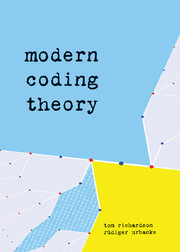Book contents
- Frontmatter
- Contents
- PREFACE
- 1 INTRODUCTION
- 2 FACTOR GRAPHS
- 3 BINARY ERASURE CHANNEL
- 4 BINARY MEMORYLESS SYMMETRIC CHANNELS
- 5 GENERAL CHANNELS
- 6 TURBO CODES
- 7 GENERAL ENSEMBLES
- 8 EXPANDER CODES AND FLIPPING ALGORITHM
- A ENCODING LOW-DENSITY PARITY-CHECK CODES
- B EFFICIENT IMPLEMENTATION OF DENSITY EVOLUTION
- C CONCENTRATION INEQUALITIES
- D FORMAL POWER SUMS
- E CONVEXITY, DEGRADATION, AND STABILITY
- Authors
- Index
4 - BINARY MEMORYLESS SYMMETRIC CHANNELS
Published online by Cambridge University Press: 05 September 2012
- Frontmatter
- Contents
- PREFACE
- 1 INTRODUCTION
- 2 FACTOR GRAPHS
- 3 BINARY ERASURE CHANNEL
- 4 BINARY MEMORYLESS SYMMETRIC CHANNELS
- 5 GENERAL CHANNELS
- 6 TURBO CODES
- 7 GENERAL ENSEMBLES
- 8 EXPANDER CODES AND FLIPPING ALGORITHM
- A ENCODING LOW-DENSITY PARITY-CHECK CODES
- B EFFICIENT IMPLEMENTATION OF DENSITY EVOLUTION
- C CONCENTRATION INEQUALITIES
- D FORMAL POWER SUMS
- E CONVEXITY, DEGRADATION, AND STABILITY
- Authors
- Index
Summary
We now broaden our scope of channels from the binary erasure channel (BEC) to the class of binary memoryless symmetric (BMS) channels. Many concepts encountered during our study of the BEC still apply and reappear suitably generalized. It might at first seem that this expanded class of channels is still restricted and special and that we are only covering a small portion of the large volume of channels encountered in practice. Actually, however, a wide range of situations can be dealt with rather straightforwardly once we have mastered BMS channels. One should therefore view the following as part of the foundation upon which much of communications rests.
Sections 4.2–4.10 recapitulate Sections 3.5–3.6, and 3.8–3.14 in this more general setting and these sections form the core material. The remaining sections can be read in essentially any order. They contain either more advanced topics or less accessible material.
General BMS channels are more mathematically challenging than the BEC. Section 4.1 summarizes the necessary prerequisites. Our advice: quickly skim it so you know what material it contains but do not study it in detail. At any point later, when the need arises, you can return to fill in gaps.
- Type
- Chapter
- Information
- Modern Coding Theory , pp. 175 - 290Publisher: Cambridge University PressPrint publication year: 2008

